eCommerce Replatforming: Steps for Migration & Checklist Inside

What’s Inside
- What Is Replatforming In eCommerce?
- What Are the Benefits of eCommerce Replatforming?
- 6 Key Factors to Consider Before Replatforming Your eCommerce Site
- What Are the Challenges in eCommerce Replatforming?
- Replatform vs Redesign – Sorting the Differences!
- What Are the Types of eCommerce Platforms to Evaluate Before Migrating?
- What Are the Steps for eCommerce Replatforming?
- Why Experro Is the Best Choice for eCommerce Replatforming?
- Conclusion
- Effective eCommerce replatforming enhances scalability and customer experience, ensuring your platform grows with your business.
- A thorough eCommerce replatforming checklist minimizes risks such as data loss and ensures a smooth migration.
- Implementing best practices in eCommerce replatforming can significantly minimize technical glitches and operational disruptions.
- Experro streamlines your eCommerce platform migration with tailored solutions and strategic expertise, optimizing your business's digital transformation.
Are you looking forward to improving your online store's functionality?
If so, eCommerce replatforming might be the solution you need.
This process involves moving your online store to a new platform to enhance functionality and adapt to changing business needs.
With the rapid evolution of technology and consumer expectations, staying on an outdated platform can limit your growth and competitiveness.
Replatforming allows you to take advantage of the latest features, improve site performance, and provide a better user experience.
It can also help streamline your operations, making it easier to manage inventory, process orders, and analyze customer data.
Now, let’s discuss eCommerce replatforming in detail.
What Is Replatforming In eCommerce?
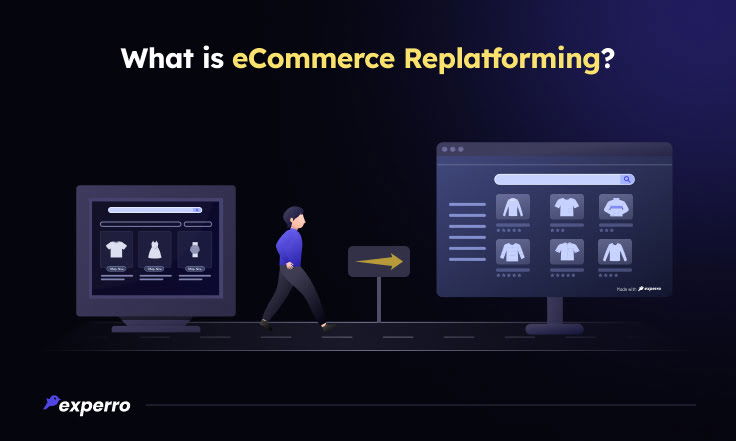
eCommerce replatform definition: It is the process of switching an online business from one digital platform to another to meet evolving needs better.
Currently, 27% of eCommerce businesses are thinking about eCommerce replatforming as this process aims to improve scalability and user experience.
This process aims to improve scalability and user experience. Effective eCommerce platform migrations are important for businesses aiming to enhance operational efficiencies and customer engagement.
What Are the Benefits of eCommerce Replatforming?
eCommerce replatforming offers businesses the opportunity to modernize their digital presence, and meet changing customer expectations.
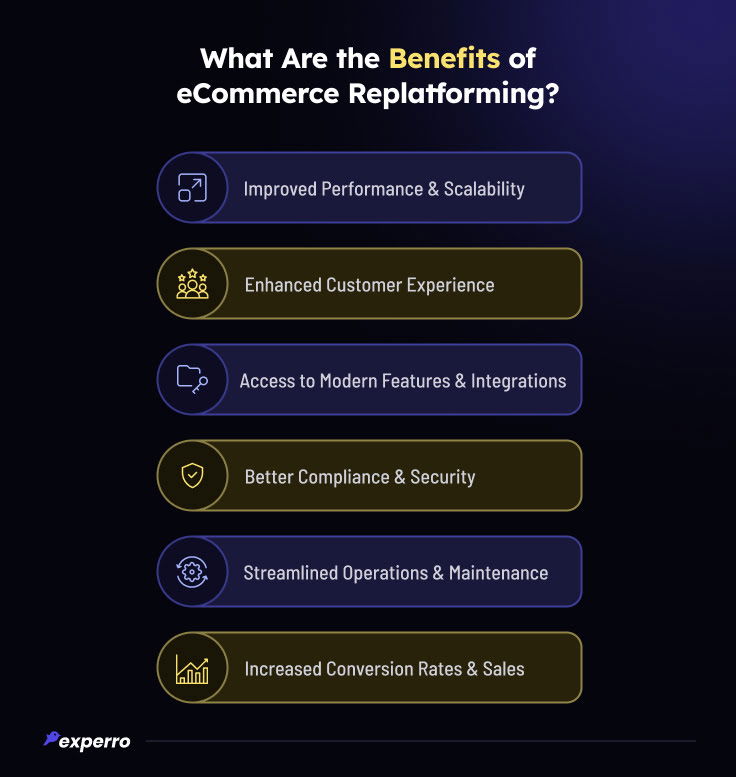
By undergoing an eCommerce platform migration, companies get numerous advantages, from improved performance to better customer engagement.
1. Improved Performance and Scalability
How does eCommerce replatforming improve performance and scalability?
By transitioning through eCommerce replatforming, businesses manage increased traffic and transaction volumes efficiently.
This scalability ensures that your platform can grow with your business, maintaining high performance, thus supporting robust growth.
2. Enhanced Customer Experience
Did you know that customers are willing to pay 16% more for an exceptional customer experience?
Such improvements can significantly boost customer satisfaction and loyalty, directly impacting the business's overall success.
Enhanced navigation, faster checkout processes, and improved site aesthetics contribute to an improved user experience that can set a brand apart from its competitors.
3. Access to Modern Features and Integrations
Replatforming allows eCommerce businesses to adopt the latest features and technologies, enhancing their performance, functionality, and user experience.
Integrating eCommerce analytics, AI and personalized marketing tools can transform the user experience and operational efficiency.
These modern capabilities enable businesses to offer targeted promotions and content, better meeting the needs and expectations of their customers.
4. Better Compliance and Security of Your eCommerce Business
Staying compliant with the latest security measures is essential.
eCommerce platform migrations often enhance security protocols and ensure compliance with data protection regulations, protecting the business and its customers.
This helps build customer trust and protects the business from potential legal and security-related repercussions.
5. Streamlined Operations and Maintenance
How do modern platforms improve eCommerce operations?
Modern platforms can simplify the backend operations of an eCommerce business, making it easier to manage day-to-day activities.
This streamlined approach can reduce maintenance costs and free up resources for other strategic initiatives.
Improved backend functionality, such as inventory management and order processing, can significantly enhance operational efficiency.
6. Increased Conversion Rates and Sales
A faster, more reliable, and user-friendly eCommerce platform can lead to higher conversion rates as it helps to meet user expectations.
eCommerce replatforming solutions focus on optimizing the customer journey, often resulting in increased sales and improved ROI.
Businesses can encourage more transactions and repeat business by reducing friction in the shopping process and providing a seamless experience from browsing to purchase.
Investing in eCommerce replatforming services is about upgrading technology and strategically positioning for future growth and success.
Let’s learn more about the factors to be considered before eCommerce replatforming.
6 Key Factors to Consider Before Replatforming Your eCommerce Site
When planning to migrate your eCommerce site, it's crucial to carefully consider several key factors to ensure a smooth transition and future growth.
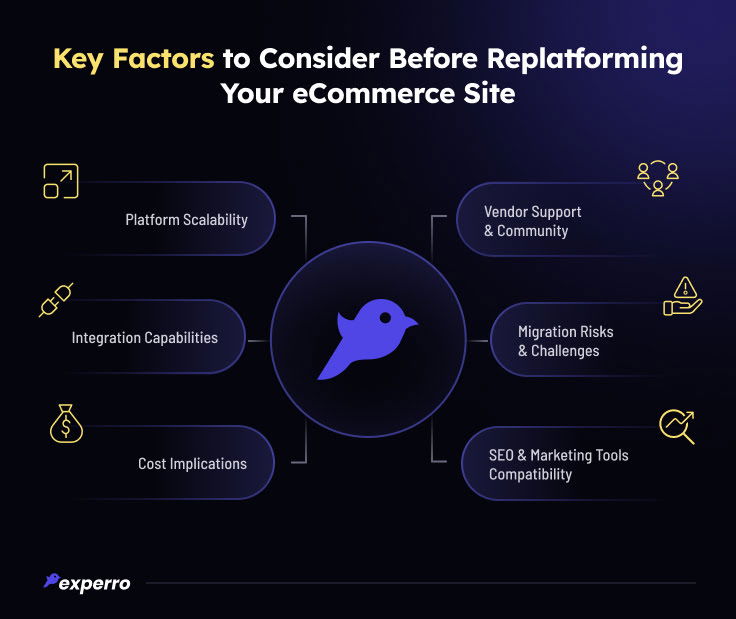
Here's a closer look at six essential elements to evaluate before considering an eCommerce replatforming project:
1. eCommerce Platform Scalability
When considering eCommerce replatforming, scalability should be your top priority. Ensure the new platform can handle increased traffic and expanding product lines as your business grows.
A scalable eCommerce solution helps you adapt to market changes without frequent migrations.
It is important for businesses, especially in B2B sectors, to choose a platform that can scale both vertically and horizontally, accommodating growth in customer transactions and data management.
2. Integration Capabilities
A key aspect of replatforming eCommerce involves assessing integration capabilities. Your new platform should seamlessly integrate with existing software, including CRM, ERP, and other marketing tools.
Effective integration enhances operational efficiency and customer experiences.
Additionally, look for platforms that offer APIs and plugins that simplify the integration of new tools as your business evolves.
If migration isn't feasible, consider easy BigCommerce integration with Experro to maintain continuity while enhancing functionality.
3. Cost Implication on eCommerce Platforms
eCommerce platform migration can be costly in terms of initial expenses and long-term operational costs.
Include potential licensing, customizations, and ongoing maintenance costs in your eCommerce replatforming checklist to avoid budget overruns.
Evaluate the total cost of ownership, factoring in scalability and integration capabilities, which can significantly affect long-term costs.
4. Vendor Support and Community
Strong vendor support and an active community are invaluable during and after eCommerce platform migrations.
They provide necessary resources, updates, and troubleshooting assistance, ensuring your platform remains functional and up-to-date.
An eCommerce replatforming agency can offer additional specialized support, tailored to your specific needs and industry challenges.
5. Migration Risks and Challenges
eCommerce migration checklist should include potential risks like data loss, downtime, and technical errors.
Hire an eCommerce replatforming consultant or experts to mitigate these risks.
Thorough planning and expert help can streamline the migration process and reduce disruptions. Post the migration test thoroughly to ensure everything functions correctly.
6. SEO and Marketing Tools Compatibility
Ensure the new platform supports effective eCommerce SEO strategies by checking its compatibility with essential SEO and marketing tools.
Proper eCommerce SEO practices help maintain your site’s visibility and ranking during and after transitioning to a new platform.
It's also essential to ensure the new platform can support your existing marketing strategies or offer better alternatives to enhance your digital marketing efforts.
What Are the Challenges in eCommerce Replatforming?
eCommerce replatforming presents significant challenges, primarily due to the complexity of data migration and integration with existing systems.
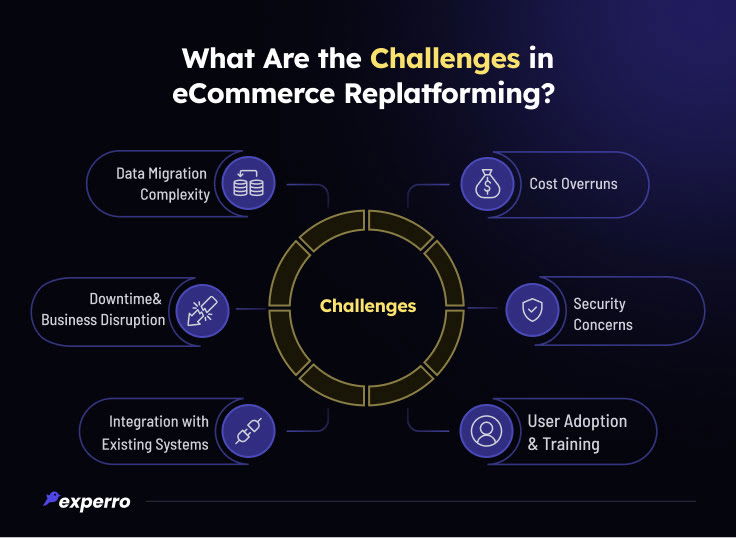
eCommerce replatforming comes with several key challenges:
1. eCommerce Data Migration Complexity
During eCommerce replatforming, one of the main hurdles is the complexity of data migration process.
Transferring data from one system to another risks data loss or corruption. A thorough eCommerce migration checklist can help track all data elements that need to be moved.
Experro simplifies the eCommerce data migration process, ensuring smooth, secure, and efficient data transfer.
2. Downtime and Business Disruption
Replatforming eCommerce operations can lead to significant downtime, disrupting business activities.
Minimizing downtime is critical to maintaining customer service and sales. Planning for a gradual switch-over or choosing a low-traffic period can mitigate these issues.
Experro ensures a seamless eCommerce replatforming experience with minimal downtime and disruption.
3. Integration with Existing System
Integrating the new platform with existing systems poses a significant challenge in eCommerce platform migrations.
Compatibility issues can arise, leading to additional customization and configuration work. Utilizing eCommerce replatforming solutions that offer flexible integration capabilities can streamline this process.
Experro simplifies eCommerce platform migrations with its flexible integration capabilities, minimizing compatibility issues, and streamlining the process.
4. Cost Overruns
Budgeting accurately for eCommerce replatforming is tricky, and cost overruns are common.
Unexpected technical challenges and extended timelines can increase costs. An eCommerce replatforming checklist helps anticipate potential financial pitfalls.
Experro provides reliable eCommerce replatforming services, ensuring quality and cost-effectiveness to help you stay within budget.
5. Security Concerns
Security is crucial in eCommerce platform migration. Protecting sensitive customer data during and after the transition requires robust security measures.
It's essential to incorporate advanced security protocols and conduct thorough testing. Hiring an eCommerce replatforming services provider with a strong security track record can help address these concerns effectively.
Experro employs advanced security protocols and rigorous testing to protect sensitive customer data throughout the transition.
6. User Adoption and Training
User adoption and training are crucial for the success of any replatform eCommerce initiative. Employees must be trained on the new system to ensure smooth operation.
Detailed training sessions and support can ease this transition, leading to better outcomes and reduced chances of B2B eCommerce replatforming failures.
With Experro's user-friendly interface, one can quickly adapt to the new system, ensuring a seamless transition and maximizing productivity.
Replatform vs Redesign – Sorting the Differences!
Replatforming and redesigning are two different approaches. These are often considered by businesses looking to enhance their eCommerce presence.
While both processes aim to improve the performance and functionality of eCommerce platforms, they serve different purposes and involve different strategies.
| Feature | Replatforming | Redesign |
| Primary Focus | Upgrading or changing the underlying platform or technology. | Updating the visual and user interaction aspects. |
| Purpose | To improve performance, scalability, and integration capabilities. | To enhance user experience and site aesthetics. |
| Common Activities | eCommerce migrations, moving to cloud platforms, application replatforming. | Redefining layout, updating graphics, improving navigation. |
| Impact on UX | Minimal direct impact on user interface unless specifically targeted. | Direct significant impact on how users interact with the site. |
| Service Providers | Experro, eCommerce migration services, etc. | Design agencies, UX/UI specialists. |
| Considerations | eCommerce replatforming design considerations, stability during eCommerce site migration. | User feedback, modern design trends, brand consistency. |
| Examples | eCommerce data migration to Experro or moving eCommerce stack to cloud. | Complete site visuals and layout. |
What Are the Types of eCommerce Platforms to Evaluate Before Migrating?
Evaluating the right type of eCommerce platform is crucial for successful eCommerce migration.
Let’s discuss the types of eCommerce platforms:
1. SaaS (Software as a Service) Platforms
These platforms are popular for their convenience and scalability.SaaS platforms are often chosen for their ability to handle updates and maintenance without significant involvement from the user.
This makes them a favorable choice for businesses that prioritize ease of use and efficiency.
2. PaaS (Platform as a Service) Platforms
These platforms offer more control over applications and infrastructure than SaaS. They are suitable for businesses aiming to tailor their eCommerce replatforming design considerations.
Here, application replatforming allows for significant customization and scalability.
PaaS solutions are particularly beneficial for companies that need to integrate complex business logic or third-party services directly into their ecommerce platforms.
3. On-Premise eCommerce Platforms
These platforms provide complete control over the eCommerce environment. They require substantial investment in infrastructure and maintenance but are best for security measures.
The eCommerce data migration to such platforms demands planning and execution.
This platform type is preferred by businesses that have specific compliance requirements or those that operate in industries where data security is critical.
4. Headless eCommerce Platforms
These platforms separate the front end from the backend operations, allowing for more creative freedom in website replatforming.
Platforms providing headless solutions like Experro are perfect for brands seeking to enhance customer experience through innovative, personalized content delivery.
Headless platforms enable marketers and developers to work more independently, speeding up content updates and enabling faster responses to market changes.
5. Hybrid eCommerce Platforms
These platforms combine the features of both on-premise and cloud-based solutions, offering flexibility and control.
This type is ideal for businesses undergoing eCommerce migrations that require a balanced approach of security and adaptable cloud features.
Hybrid platforms are particularly valuable for organizations that are transitioning from a traditional on-premise setup to a more modern infrastructure.
Now, let’s learn the steps for eCommerce replatforming in the below section.
What Are the Steps for eCommerce Replatforming?
Here are the detailed steps for eCommerce replatforming:
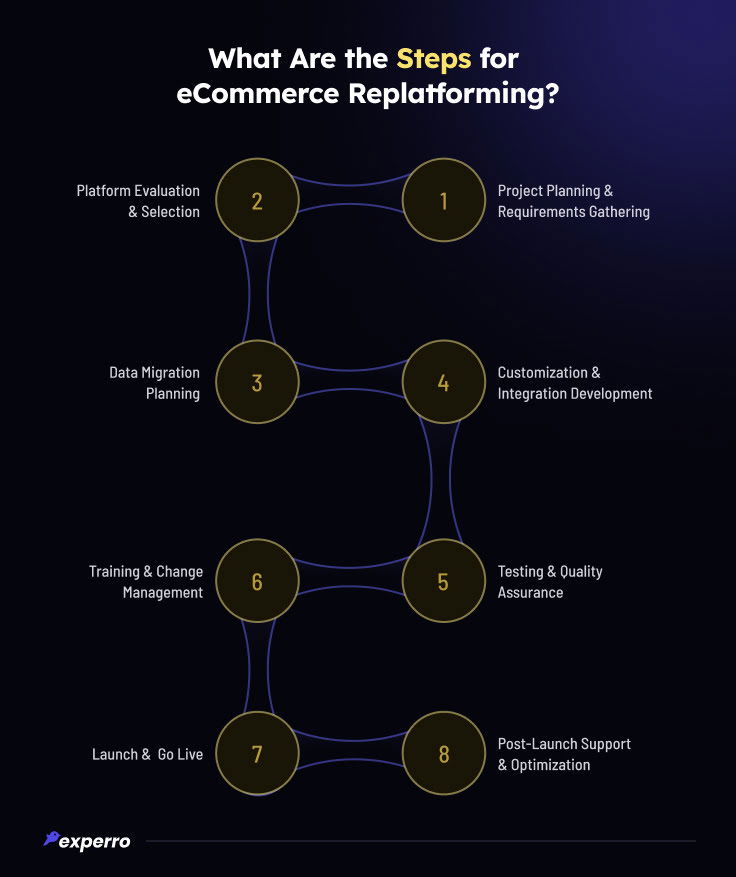
1. Project Planning and Requirements Gathering
Before you can start replatforming eCommerce, it's crucial to lay a strong foundation. This first step involves thorough planning and gathering specific requirements for your business needs.
It's important to define your goals, budget, and timelines clearly. Consulting with an eCommerce replatforming consultant can provide valuable insights to help tailor your approach.
2. Platform Evaluation and Selection
Choosing the right platform is pivotal in eCommerce platform migration. Evaluate multiple platforms to see which best matches your technical requirements and business objectives.
Consider factors like scalability, security, and compatibility with existing systems. An eCommerce replatforming agency can offer expert guidance in selecting the most suitable platform.
3. Data Migration Planning
Effective eCommerce platform migrations require planning to ensure data integrity and security.
You must determine what data needs to be transferred (such as product details, customer information, and past orders), how it will be moved, and how to handle data discrepancies.
Utilizing an eCommerce migration checklist can help streamline this complex replatforming process.
4. Customization and Integration Development
Most businesses will need custom features and integration with other systems during an eCommerce replatform.
This stage involves developing these customizations and ensuring that new integrations work seamlessly with the chosen platform.
This can include payment gateways, CRM systems, and inventory management tools.
5. Testing and Quality Assurance
Quality assurance is important in eCommerce replatforming. This step ensures that the new platform functions without bugs or issues.
It systematically tests the platform's functionalities, performance, and security. Regular testing helps identify and resolve issues before going live.
6. Training and Change Management
Change management is essential in B2B eCommerce replatforming. Training your team to use the replatformed store will ensure a smoother transition effectively.
It's important to prepare support structures and provide resources to address any concerns that arise during and after the switch.
7. Launch and Go Live
The launch period is when your new eCommerce platform goes live. This should be strategically planned to minimize disruptions in your operations.
Effective eCommerce replatforming services include conducting a final pre-launch review and preparing a detailed strategy to ensure a successful launch.
8. Post-Launch Support and Optimization
After going live, ongoing support and optimization are crucial. This involves monitoring the platform's performance, making necessary adjustments, and optimizing features for better results.
Engaging with an eCommerce replatforming consultancy can help align with the platform to meet evolving business needs. It also supports in avoiding B2B eCommerce replatforming failures.
What Does the eCommerce Replatforming Checklist Cover?
eCommerce replatforming involves upgrading or changing your eCommerce system to a more robust platform, enhancing functionality and scalability.
To ensure a smooth transition, follow this concise eCommerce Replatforming Checklist.
✅ Evaluate eCommerce replatforming design considerations and focus on user experience, scalability, and integration capabilities.
✅ Select eCommerce migration services or a platform that offers a proven track record and necessary expertise.
✅ Review the guide for an eCommerce migration and follow established guidelines to avoid common pitfalls.
✅ Assess eCommerce site migration needs to determine the scope and complexity of your site transfer.
✅ Plan and hire eCommerce data migration services or choose a DXP to ensure data integrity and security throughout the process.
✅ Incorporate eCommerce migration case study insights to learn from the successes and challenges faced by others.
✅ Move eCommerce stack to cloud to consider cloud solutions for scalability and performance.
✅ Understand how authored content could fuel migration and use high-quality content to enhance user engagement post-migration.
By adhering to the above checklist, your eCommerce replatforming effort will be well-positioned for success.
Why Experro Is the Best Choice for eCommerce Replatforming?
Choosing Experro for your eCommerce replatforming ensures a smooth transition with scalable solutions that grow alongside your business.
Experro is recognized for its robust functionality and seamless eCommerce platform migration capabilities, making it an ideal choice for companies looking to enhance their digital infrastructure.
One of the key strengths of Experro is its scalability, which is essential for B2B eCommerce replatforming. This adaptability prevents performance compromises and supports business expansion seamlessly.
Furthermore, Experro excels in integrating with Shopify and other platforms, ensuring smooth connections with existing CRM, marketing tools, and Shopify migration agency services.
Conclusion
In conclusion, successful eCommerce replatforming is a strategic process that can significantly enhance your business's digital presence and operational efficiency.
Whether you're looking for improved customer experience, scalability, or integration, replatforming eCommerce requires careful planning and execution.
To ensure a smooth transition and avoid common problems, it's essential to follow a thorough eCommerce replatforming checklist and seek guidance from a skilled eCommerce replatforming consultant.
Ultimately, this transition boosts performance and strengthens your competitive edge in an evolving market.
Stay tuned with us for further updates or schedule a call with our team for one-on-one discussion!
FAQs


Pallavi Dadhich
19 June 2024Pallavi is an ambitious author known for her expertise in crafting compelling content across various domains. Beyond her professional pursuits, Pallavi is deeply passionate about continuous learning, often immersing herself in the latest industry trends. When not weaving words, she dedicates her time to mastering graphic design.